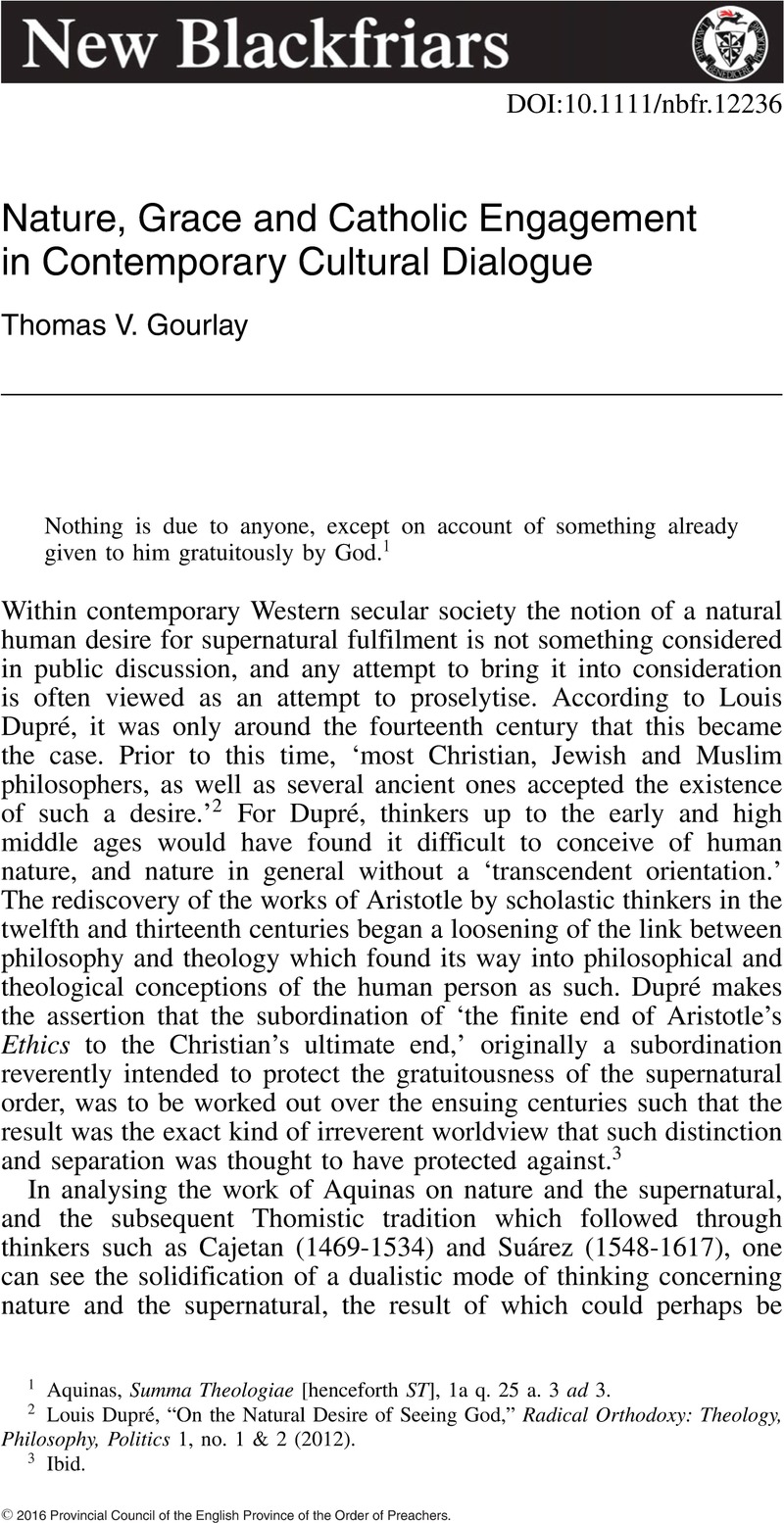No CrossRef data available.
Article contents
Nature, Grace and Catholic Engagement in Contemporary Cultural Dialogue
Published online by Cambridge University Press: 01 January 2024
Abstract

- Type
- Original Article
- Information
- Copyright
- Copyright © 2016 Provincial Council of the English Province of the Order of Preachers
References
1 Aquinas, Summa Theologiae [henceforth ST], 1a q. 25 a. 3 ad 3.
2 Dupré, Louis, “On the Natural Desire of Seeing God,” Radical Orthodoxy: Theology, Philosophy, Politics 1, no. 1 & 2 (2012)Google Scholar.
3 Ibid.
4 Rowland, Tracey, “Theology and Culture,” in Being Holy in the World: Theology and Culture in the Thought of David L. Schindler, ed. Healy, Nicholas J. Jr. and Schindler, D.C. (Grand Rapids, Michigan: Wm. B Eerdmans 2011), 56Google Scholar.
5 Bauerschmidt, Frederick Christian, Thomas Aquinas: Faith, Reason, and Following Christ, ed. Gorringe, Timothy, Jones, Serene, and Ward, Graham, Christian Theology in Context (Oxford: Oxford University Press, 2013), 129CrossRefGoogle Scholar.
6 Ibid.
7 Ibid.
8 Ibid.
9 Riches, Aaron, “Christology and Duplex Hominis Beatitudo: Re-Sketching the Supernatural Again,” International Journal of Systematic Theology 14, no. 1 (2012), 46CrossRefGoogle Scholar.
10 Bauerschmidt, Thomas Aquinas: Faith, Reason, and Following Christ, 129.
11 ST I–II, q. 62, a. 1, corpus. Cited in De Lubac, Henri, “Duplex Hominis Beatitudo,” Communio: International Catholic Review 35, no. 4 (2008), trans. Riches, Aaron and Candler, Peter M. Jr.Google Scholar
12 Augustine, Confessions 1.1.1.
13 Bauerschmidt, Thomas Aquinas: Faith, Reason, and Following Christ, 130.
14 Ibid.
15 Jean-Yves Lacoste, quoted on the dust jacket of Milbank, John, The Suspended Middle: Henri De Lubac and the Debate Concerning the Supernatural (London: SCM Press, 2005)Google Scholar.
16 Kerr, Fergus, Twentieth Century Catholic Theologians: From Neoscholasticism to Nuptial Mysticism (Oxford: Blackwell Publishing, 2007), 76Google Scholar.
17 See Bauerschmidt, Thomas Aquinas: Faith, Reason, and Following Christ, 133.
18 Pius XII, Humanii Generis: Concerning Some False Opinions Threatening to Undermine the Foundations of Catholic Doctrine. http://w2.vatican.va/content/pius-xii/en/encyclicals/documents/hf_p-xii_enc_12081950_humani-generis.html (accessed 22 March, 2015), 26.
19 Kerr, Twentieth Century Catholic Theologians: From Neoscholasticism to Nuptial Mysticism, 76.
20 de Lubac, Henri, At the Service of the Church: Henri De Lubac Reflects on the Circumstances That Occasioned His Writings (San Francisco: Communio Books, 1993), 71Google Scholar.
21 Bauerschmidt, Thomas Aquinas: Faith, Reason, and Following Christ, 131.
22 Ibid, 131.
23 Contra Gentiles lib. 3 cap. 50 n. 7, cited in ibid, 131.
24 Ibid, 131.
25 Ibid. Citing Aquinas, Summa Theologiae 1a q. 1 a. 8 ad 2.
26 ST I-II, q. 5, a. 5, co. cited in De Lubac, “Duplex Hominis Beatitudo.”
27 Chesterton, G. K., The Collected Works of G.K. Chesterton, vol. 1 (San Francisco: Ignatius Press, 1986), 88Google Scholar.
28 Riches, “Christology and Duplex Hominis Beatitudo: Re-Sketching the Supernatural Again”, 66.
29 Ibid.
30 Vatican Council II, Gaudium et Spes: Pastoral Constitution on the Church in the Modern World. http://www.vatican.va/archive/hist_councils/ii_vatican_council/documents/vat-ii_const_19651207_gaudium-et-spes_en.html 7 Dec. 1965, (accessed 14 Nov. 2014), n. 22.
31 de Lubac, Henri, Catholicism: A Study of Dogma in Relation to the Corporate Destiny of Mankind (New York: Longmans, Green, 1950), 339Google Scholar.
32 Ibid, 340.
33 Riches, “Christology and Duplex Hominis Beatitudo: Re-Sketching the Supernatural Again”, p. 67; citing Williams, A. N. The Ground of Union: Deification in Aquinas and Palamas (Oxford: Oxford University Press, 1999), 90CrossRefGoogle Scholar.
34 Girgis, Sherif, Anderson, Ryan T., and George, Robert P., What Is Marriage? Mand and Woman: A Defense (New York: Encounter Books, 2012)Google Scholar (back jacket) - emphasis mine
35 Ibid, 10.
36 Boersma, Hans, “Defending Marriage: A Review of ‘What Is Marriage: Man and Woman: A Defense,’ by Sherif Girgis, Robert P. George, and Ryan T. Anderson,” First Things, no. March (2013), 52Google Scholar.
37 David L. Schindler, from the introduction to the 1998 edition of, de Lubac, Henri, The Mystery of the Supernatural, trans. Sheed, Rosemary (New York: The Crossroad Publishing Company, 1998)Google Scholar, xxx.
38 Rowland, “Theology and Culture”, 58.
39 Ibid.
40 Ibid, 58; citing de Lubac, Henri, “Nature and Grace,” in The World in History: The St Xavier Symposium, ed. Burke, T. Patrick (London: Collins, 1968), 32-33Google Scholar.
41 von Balthasar, Hans Urs, “Theology and Sanctity,” in Explorations in Theology, Vol. 1, Word Made Flesh, trans. Littledale, A.V. and Dru, Alexandre (San Francisco, 1989), 195Google Scholar.
42 A simple glance at the kind of attention received by the twitter feed of Ryan T. Anderson, one of the authors of What is Marriage is enough to note the severity of the criticisms made against his argument. This includes unfair ad hominem attacks as well the kind of “Trolling” common to online disagreements of this kind.
43 Benedict XVI, Lecture by the Holy Father Benedict XVI at the University of Rome ‘La Sapienza’, http://w2.vatican.va/content/benedict-xvi/en/speeches/2008/january/documents/hf_ben-xvi_spe_20080117_la-sapienza.html, (accessed 14 November, 2014).
44 Schindler, David L., ‘Grace and the Form of Nature and Culture’, in Catholicism and Secularization in America: Essays on Nature, Grace, and Culture, ed. Schindler, David L. (Notre Dame; Huntington, Indiana: Our Sunday Visitor, 1990), 14-15Google Scholar.




